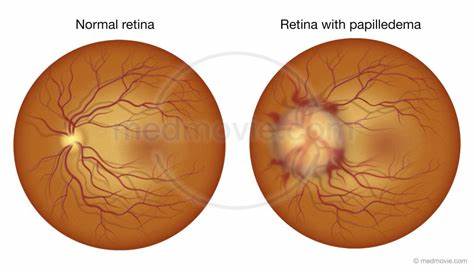Makindo Medical Notes"One small step for man, one large step for Makindo" |
|
|---|---|
| Download all this content in the Apps now Android App and Apple iPhone/Pad App | |
| MEDICAL DISCLAIMER: The contents are under continuing development and improvements and despite all efforts may contain errors of omission or fact. This is not to be used for the assessment, diagnosis, or management of patients. It should not be regarded as medical advice by healthcare workers or laypeople. It is for educational purposes only. Please adhere to your local protocols. Use the BNF for drug information. If you are unwell please seek urgent healthcare advice. If you do not accept this then please do not use the website. Makindo Ltd. |
Papilloedema
-
| About | Anaesthetics and Critical Care | Anatomy | Biochemistry | Cardiology | Clinical Cases | CompSci | Crib | Dermatology | Differentials | Drugs | ENT | Electrocardiogram | Embryology | Emergency Medicine | Endocrinology | Ethics | Foundation Doctors | Gastroenterology | General Information | General Practice | Genetics | Geriatric Medicine | Guidelines | Haematology | Hepatology | Immunology | Infectious Diseases | Infographic | Investigations | Lists | Microbiology | Miscellaneous | Nephrology | Neuroanatomy | Neurology | Nutrition | OSCE | Obstetrics Gynaecology | Oncology | Ophthalmology | Oral Medicine and Dentistry | Paediatrics | Palliative | Pathology | Pharmacology | Physiology | Procedures | Psychiatry | Radiology | Respiratory | Resuscitation | Rheumatology | Statistics and Research | Stroke | Surgery | Toxicology | Trauma and Orthopaedics | Twitter | Urology
Related Subjects:
|Brain tumour s
|Astrocytomas
|Brain Metastases
|Tuberous sclerosis
|Turcot's syndrome
|Lhermitte Duclos Disease
|Oligodendroglioma
|Acute Hydrocephalus
|Intracranial Hypertension
|Primary CNS Lymphoma (PCNSL)
👁️ Papilloedema is swelling of the optic disc due to raised intracranial pressure (ICP).
It requires emergency referral to ophthalmology/neuro services and urgent brain imaging (including MRV/CTV to exclude cerebral venous sinus thrombosis).
The mechanism of optic nerve damage is axoplasmic flow stasis causing intraneuronal ischaemia → untreated cases risk permanent vision loss.
Assessing optic discs can be challenging. Mydriasis is not usually required, but 0.5% tropicamide can be used if necessary.
Always document if dilating drops are used.
Papilloedema = raised ICP until proven otherwise.
👉 Always do neuroimaging before lumbar puncture to avoid coning.
Fundoscopy: swollen disc, blurred margins, venous engorgement, haemorrhages.
Vision preserved early — differentiates from optic neuritis.

📍 About
⚠️ Causes
🔎 Pseudopapilloedema
🩺 Clinical Features
🧠 Differentials
🔬 Investigations
💊 Management
📌 Exam Tip
📚 References